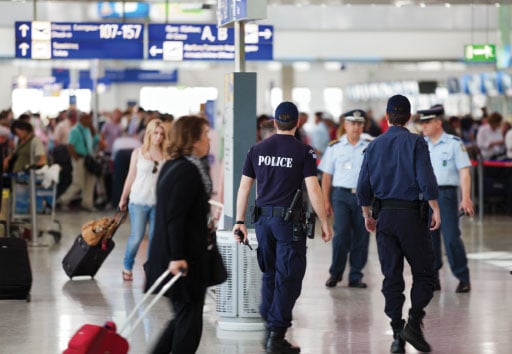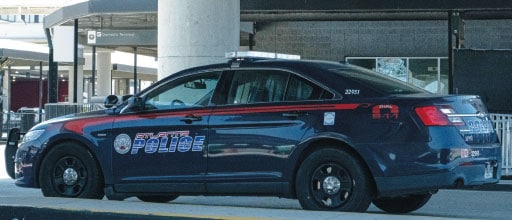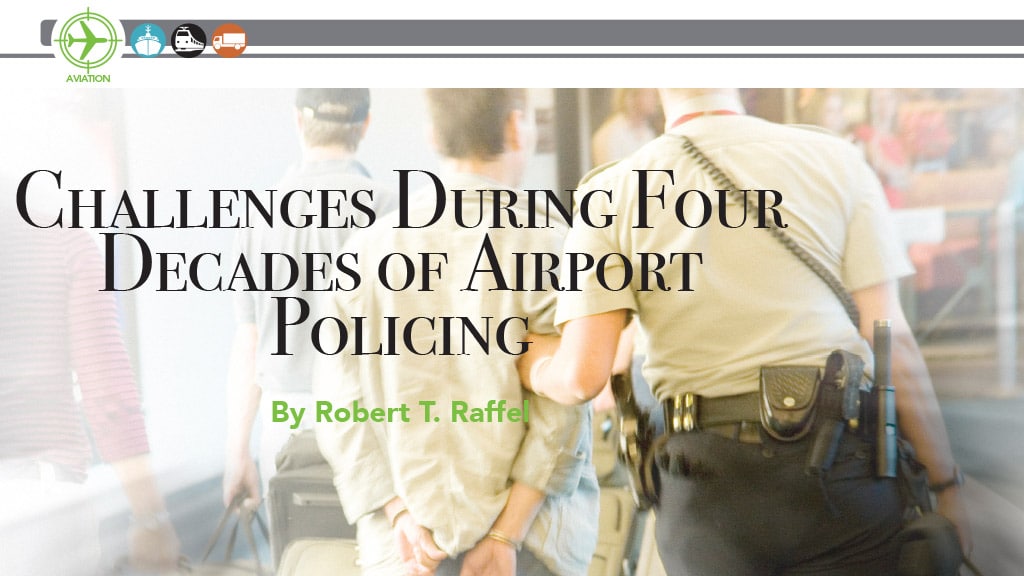Busy airports are microcosms of small cities. Processes and procedures exist in a mirror-like image of the urban environment, including the work of law enforcement. Although technology has advanced, the fundamental mission of airport police work has not changed much in forty years, says airport law enforcement expert Robert T. Raffel.
My interest in and examination of law enforcement activities in an airport environment dates back to 1983 when I wrote “Criminal Investigation at Airports: An Overview,” for the FBI Law Enforcement Bulletin. For this look back at the challenges for this piece, given the significant amount of time involved, I was interested in discovering and describing the changes, if any, that have taken place over the span of nearly four decades, since that original article was published.
Interestingly, as my examination proceeded, I discovered that aside from inevitable advances in culture and technology, the broader scope of airport police work has changed little over the passage of time. The fundamentals of airport policing remain similar to what they were in 1983; the basics remain unchanged. What I consider to be the most critical issues involving police activities at airports are described below:
Airports, relationships & regulations
As I pointed out in 1983, airports are much like small cities. Passengers represent a diverse demographic within that environment. Retail establishments, salons, banks, restaurants – are all present in the modern airport. The biggest difference, of course, is that no one lives there. “Citizens” are highly transient. Despite the hectic atmosphere however, infrastructure exists to support the passenger/citizen flow; an airport in a rush period is a study in organized chaos. Medical clinics, police and fire departments together with other support-related processes and procedures exist in a mirror-like image of an urban environment. With some significant differences.
Airports themselves can be private, governmental or a combination of the two. The airport police department is thus a reflection of the type of airport involved.
A representative example of the complex relationships that can exist in airports in the U.S. is presented by the Baltimore-Washington International Airport (BWI), located roughly between Baltimore and Washington, D.C. The Maryland Aviation Administration (MAA) is the owner and operator of Baltimore/Washington International Thurgood Marshall Airport (BWI). Originally, law enforcement activities at BWI (then called Friendship Airport) were managed by its own, discrete police department, trained at the Baltimore City Police Academy. The Airport officer’s law enforcement duties and powers were similar to their counterparts in the city P.D., albeit with constrained jurisdictional limitations — approximately within a one-mile radius of the airport proper. Mutual aid agreements with the county police department, the state police and other appropriate entities operating on local, state and federal levels, helped ensure continuity of peacekeeping activities — although sometimes with a commensurate level of confusion.
As BWI evolved, so did the P.D. The airport itself became known as the Baltimore-Washington International Airport (hence BWI — which was later modified (if not simplified) as the Baltimore-Washington International Thurgood Marshall Airport). The State Aviation Authority police department’s duties were taken over by the Maryland State Police Airport Division. This organization in its turn became The Maryland Transportation Authority Police. It is notable that despite changes in policing organizations, their nomenclature and even duties, this type of evolution is not unusual for U.S.-based airport police organizations. Law enforcement officers, or “LEOs” in airport jargon, shared most of the same law enforcement powers as their urban contemporaries.
Most of these departments are regulated, managed and funded by the organization that governs the airport at large, but operating under an authority that bestows police power and enforcement prerogatives. An example of this is the Orlando Police Department’s (OPD) Airport Division which, although a part of the larger, sister organization, provides law-enforcement services to the airport community. Their law enforcement powers and the ability to enforce applicable laws and ordinances — both civilian and aviation-related — are conferred upon them through the regulating authority.

Due to the complexity of airport operations, criminal and civil enforcement takes place on a number of levels, overseen by a myriad of organizations. The airport police department, per se, may work on Federal, State and/or local governmental levels. Federal enforcement activities include Immigration and Customs Enforcement (ICE and CBP in the U.S.), FBI, aspects of transportation security (TSA), among others. Federal Aviation Administration (FAA), etc. Enforcement of Local laws and regulations are the province of the airport police department in most cases.
Thus far, my examination of airport-based law enforcement may have caused more confusion than clarity. As might be imagined, this multiplicity of law enforcement organizations can become somewhat confusing to the uninitiated. Although it is possible for a LEO to successfully police an airport without having an in-depth knowledge of its’ architecture, some degree of familiarity is helpful, especially at the management level. Various activities and methods utilized to ensure this stability are examined below:
Cooperation
First and foremost, as I have alluded to above, airports are complex entities. In the realm of law enforcement, this is especially true. Immigration issues, drug and weapons smuggling activities, theft, unruly passengers and a host of federal and local criminal activities all conspire to challenge the airport law enforcement officer. Whereas in the past, airport police duties were viewed as a quasi-retirement posting, those days are history. Officers reassigned from regular police duties and thrust into the airport environment, especially absent any meaningful degree of prior training, work at a significant disadvantage. Due to the nature of airports — especially the larger ones with millions of passengers and pounds of cargo passing through each year, combined with a large variety of law enforcement and regulatory agencies involved in day-to-day operations, airport police officers and their management team should be cognizant of the challenge airport policing presents.
One of the most vital parts of managing an airport police operation is the recognition that any airport police force does not operate alone. Stove piping management prerogatives is not an option at most airports. Although airport police departments operate under varying degrees of autonomy, knowledge of where in the puzzle an airport law enforcement department properly operates, together with robust efforts to integrate the department into airport operations are essential qualities for a successful law enforcement presence.
All civilian airports, by design, play host to a number of discrete groups. Under the airport management team reside airport operations, an airport security department, airline managers, retail and business establishments and their managers, federal organizations such as FAA, TSA, FBI, ICE, CBP — in the U.S. — and other alphabet groups who share some degree of law enforcement duties and powers. In order to assist with a continuity of operations, most of these groups hold regular (mostly monthly) meetings. Some meetings are held jointly to assist with information dissemination, law enforcement operations and items of general interest. While serving as the FAA’s Federal Security Manager (a pre-TSA position) at a major U.S. airport, I held a monthly Threat Assessment Group (“TAG Team”) meeting every month. Most of the representatives from the Federal agencies attended, as well as representatives from the airport security department, local law enforcement agencies, and other interested and appropriate parties. We utilized the TAG Team as a forum to discuss current operations (thus avoiding a “blue on blue” incident) and, when necessary, shared classified information between organizational members with the requisite security clearances.
These meetings have value on several levels. First, information of general interest is given a forum for dissemination and discussion. Next, airport law enforcement managers are given an opportunity to interact with the airport management hierarchy, thus becoming involved in overall airport interests and operations. Finally, these gatherings engendered an ability to reach across the table to one’s opposite number, to recognize the man or woman next to you in the airport emergency operations center, thus fostering cooperation and teamwork, which will be discussed further below.
Organizations concerned with assisting airport law enforcement departments also exist at different levels. Beyond the police department itself, airline manager’s meetings at many airports are held monthly. Although not solely concerned with public safety issues, these groups are an invaluable source of information, assistance and personal interaction to the police department. Further along the spectrum are police departments in the area of the airport. In many instances, mutual aid agreements are in place, detailing the conditions under which aid will be rendered, and the nature of such aid. These agreements are especially prevalent among airport and neighboring fire departments. Some or all of the airport firefighters are trained specifically to fight fires on aircraft, as opposed to structural fires. The ARFF department and/or group within a department (“Aircraft rescue firefighters”) are professionals, existing in a never-ending training mode.
Moving upwards, in the U.S. (i.e., on the national level), the Airport Law Enforcement Network (ALEAN) is an invaluable source of information, intelligence and training relating to the specific areas of law enforcement at an airport. Most, if not all, U.S. airport departments are affiliated with ALEAN.
Finally, due to the nature of civil aviation, international groups exist whose duties involve the formation and promulgation of international standards involving law enforcement and public safety rules and standards at airports throughout the world. The International Civil Aviation Organization (ICAO), a branch of the United Nations, has adopted measures “…to prevent and suppress all acts of unlawful interference against civil aviation throughout the world.” ICAO has formulated and adopted 19 Annexes dealing with pertinent aspects of civil aviation, including security, which exists in its Annex 17. Each Annex contains internationally-recognized Standards and Recommended Practices (SARPS). The role ICAO plays in the word of civil aviation worldwide is hard to overlook. Each Annex, with its’ SARPS, outline baseline standards that are recommended and/or mandatory for aviation operations around the world.

Thus, groups, formal organizations and information centers exist on local, state, national and international levels at airports throughout the U.S. and the world. Any or all of these entities are available to the law enforcement professional assigned to an airport.
Training & Exercises
If asked to identify the most useful, necessary and significant item of importance to the airport police department, training would head the list. The relative complexity of an airport is discussed briefly above. As well as being a complex entity with many moving parts, much of what the airport law enforcement officer (LEO) is exposed to when assigned there differs appreciably from his or her basic police training, or what he/she experiences “on the street”. In order to function adequately in an airport environment, the officer must first gain a basic understanding of that world and its differences. Aside from baseline police duties and functions, little of the basic training most officers receive is of help in a civil aviation context. Having said this, it is enlightening to note that despite the need of specialized training for airport LEOs, there exists no standardized training regimen for such departments at a national (U.S.) level. If there were, the owning agency (TSA, perhaps) a standardized and nationally-approved AVSEC policy might be easier to stand up and to follow. As it is, training guidance as exists comes from local efforts and, to a lesser degree, TSA and ICAO levels.
This article assumes a basic level of training in police subjects, given at regular intervals to all officers in all departments. However, airport police work contains a set of requirements over and above the norm for most departments. Some requirements, for instance, pertain specifically to civil aviation. Laws and regulations pertaining to unruly passengers on board an aircraft, for example, are unique to the airport environment. Although aviation laws may be enforced at the federal level, the airport LEO is usually the first responder. Failure to submit to screening is yet another instance where the LEO is first at the scene. Attempts to bring a gun through the screening point (“I’m sorry, officer — I forgot it was in there!”) are common occurrences. In more serious cases, drug and weapons smuggling attempts are relatively frequent. These offences may fall into several jurisdictional categories. Narcotics violations are a relevant example. In the United States, a significant amount of cocaine discovered in a carry-on bag of a passenger going through a screening checkpoint might rise to the level of a felony, dependent upon the location, narcotic type and quantity. The enforcement authority could include the local LEO force, the FBI, DEA, drug task forces assigned to the airport, etc. Which agency conducts the arrest and prosecution is yet another issue which requires local cooperation and inclination. Another consideration in a world experiencing a pandemic is the degree of compliance that the travelling public accords rules involving masking, social distancing and personal protection. Although present everywhere, the threat- public health, not criminal – is especially threatening at an airport. To what extent law enforcement practitioners need to be mindful of threats to health, the general public and each other depends on the jurisdiction, training considered necessary to combat the threat, and local/federal guidelines.
In most instances, the airport itself provides many opportunities for training. Airline station managers, airport security departments, AARFF firefighters and other airport-related and -based entities train more or less continually, via both regulatory requirements as well as the emphasis the airport management team deems necessary. Training cycles occur at major airports worldwide. In many instances, the airport LEO force may choose to insert itself in an exercise simply by adding a law enforcement scenario into the plot. A full-scale down craft exercise, for example, might involve the participation of local, state and federal law enforcement agencies, area firefighters and hospitals, many generated by the activation of mutual aid agreements, the airport or local emergency operations center, and others, limited only to the availability and cooperation with those involved. A degree of creativity on the part of those organizations planning and conducting such an exercise will ensure a maximum of engagement for all concerned.
It is important to note that exercises are vital training experiences on a variety of levels. They not only give the LEO force an opportunity to concentrate on aviation-related matters but, just as importantly, such exercises give the LEO an opportunity to view the respective agencies and duties at an airport in a period of chaos and confusion. And, arguably most importantly, it provides an opportunity to familiarize themselves with the duties and responsibilities of cooperative agencies and to become cognizant of their opposite numbers. My experience leads me to believe that there is little more important than a knowledge and appreciation of other organizations. Who are the station managers? Who is the airport security director? Who do I contact for assistance in any particular incident? How do other agencies interact and cooperate with mine? This knowledge is invaluable in an airport context.
In this brief look back at airport policing during the last forty years I have painted with a broad brush and have touched only lightly on police tactics and operations. But this look outlines the challenges inherent in airport law enforcement, sketches out the fundamentals of effective LEO inclusion into the airport environment and outlines some thoughts on how best to manage an airport-based law enforcement organization. My hope is that I have helped shed light on an important and evolving area of police activity.
Robert T. Raffel was a member of the Maryland State Police. He worked for the Department of State’s Anti-Terrorism Assistance Program and FAA’s Office of Civil Aviation Security. He also served as the senior director of Public Safety for the Greater Orlando Aviation Authority. He was an associate faculty member of Embry-Riddle University’s Homeland Security Program. He is also a retired Colonel with the U.S. Army Reserve. Raffel is a graduate of New York University and the University of Maryland’s School of Law. He is married, and lives in Maryland, U.S.A.
